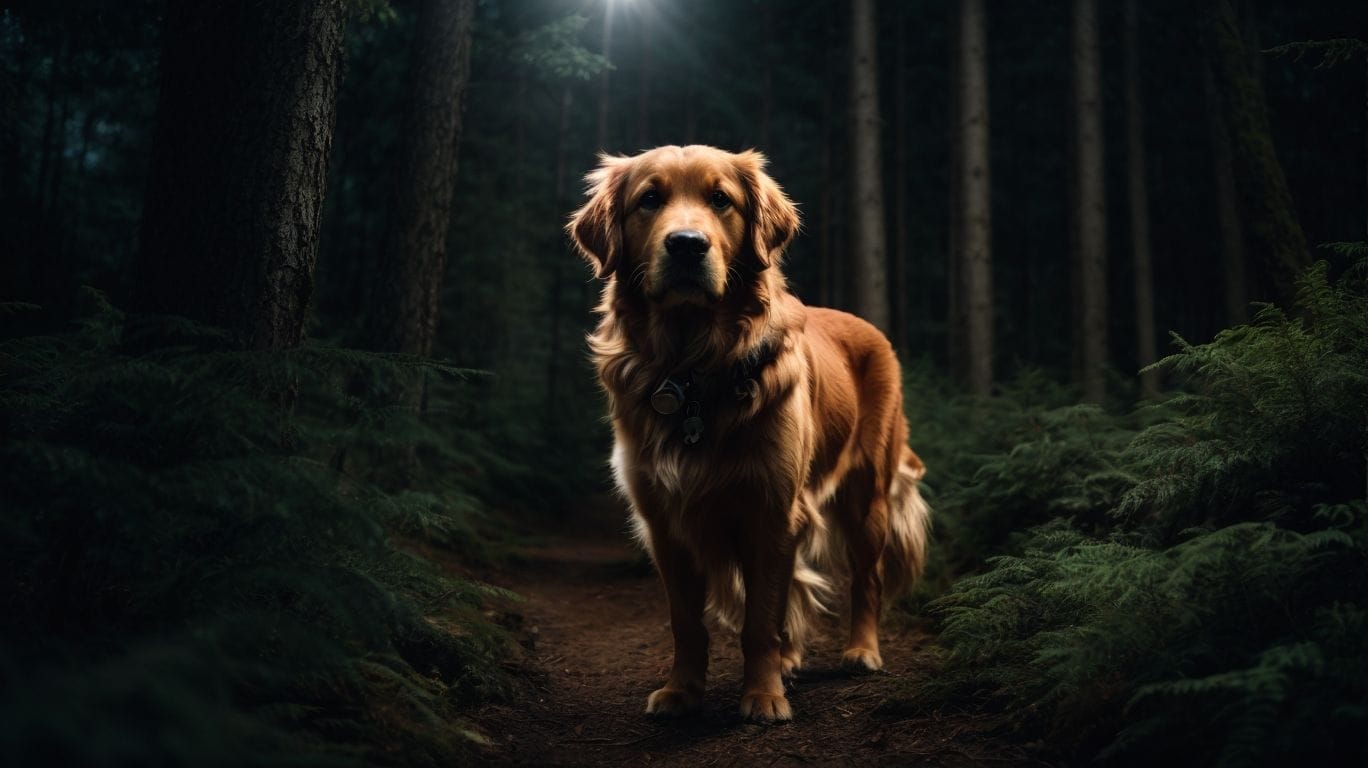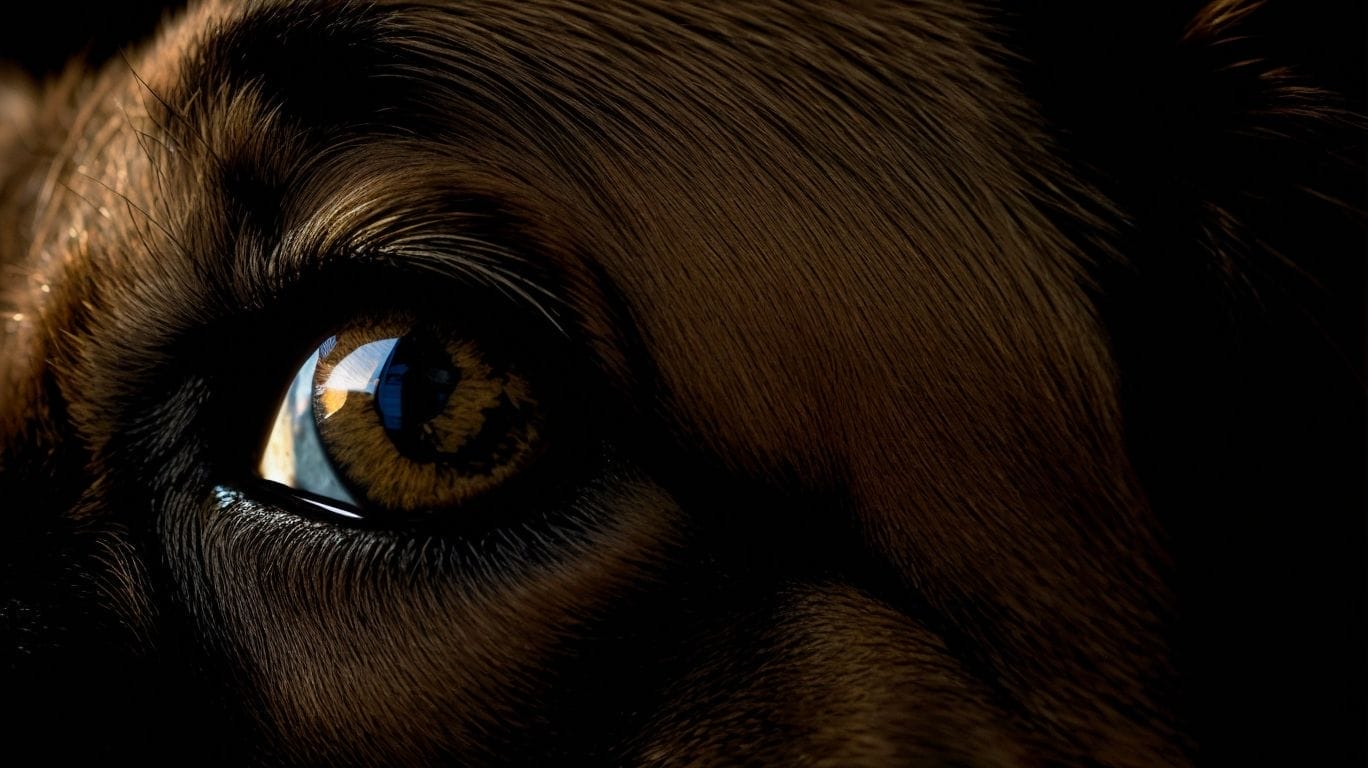Can Dogs See in the Dark? This common question has been a topic of interest for dog owners and enthusiasts. Understanding the capabilities of dog vision can provide insights into how they perceive their surroundings, especially in low-light conditions. Compared to humans, dogs have unique visual abilities that make them well-suited for seeing in the dark. An article published by the American Kennel Club sheds light on the subject. This article will delve into various aspects of dog vision, including their ability to see in the dark, the adaptations of their eyes for low light conditions, and the factors that affect their night vision. We will address some commonly held myths and misconceptions surrounding dogs’ night vision. By gaining a deeper understanding of how dogs see in the dark, you will be able to appreciate your furry friend’s remarkable visual capabilities.
Key takeaways:
1. Understanding Dog Vision: Dogs have better night vision than humans due to adaptations in their eyes, such as larger pupils and a reflective layer behind the retina called the tapetum lucidum.
2. Dog Behavior at Night: While not nocturnal, dogs are more active at dawn and dusk. This behavior is influenced by their biological clock and hunting instincts.
3. Limitations of Dog Night Vision: Dogs can see in low light but not complete darkness. Additionally, night vision varies among dog breeds, with some having better vision than others.
Can Dogs See in the Dark?

Photo Credits: Petnarnia.Com by Roger Carter
Understanding Dog Vision

Photo Credits: Petnarnia.Com by Gabriel Williams
| Aspect | Explanation |
|---|---|
| Night Vision | Dogs have superior night vision compared to humans. Their eyes contain more rods, allowing them to see better in the dark. |
| Color Vision | Understanding Dog Vision: While humans have three types of color receptors, dogs only have two. This means they see fewer colors and have trouble distinguishing between reds and greens. |
| Motion Detection | Dogs have excellent motion detection skills. They can detect even the slightest movement, making them great at tracking prey or noticing intruders. |
| Peripheral Vision | Dogs have a wider field of view, with a field of vision of around 240 degrees. This gives them a better awareness of their surroundings. |
| Visual Acuity | Despite having better night vision and panoramic vision, dogs have lower visual acuity compared to humans. Their vision is blurrier and less detailed. |
| Depth Perception | Dogs have relatively good depth perception, but it is not as accurate as humans. They rely more on other senses, such as smell and hearing, to navigate their environment. |
| Adaptation to Bright Light | Dogs have a higher tolerance for bright light due to their tapetum lucidum, a reflective layer behind their retinas. It helps to amplify available light but can cause temporary blindness when exposed to intense light. |
How Do Dogs See Compared to Humans?
Dogs have a unique way of perceiving the world compared to humans. Due to differences in their eyes, dogs see differently from us. They have a higher number of rods than cones in their retinas, which improves their vision in low-light conditions. As a result, dogs have superior night vision when compared to humans. Additionally, dogs possess a broader field of view and enhanced peripheral vision, enabling them to detect movement more effectively. On the other hand, humans have a higher visual acuity and better color vision than dogs. By understanding these disparities, we can gain insight into how our furry companions view the world around them.
In the early 1800s, an English scientist named George Cuvier conducted experiments to explore the disparity between how dogs and humans see the world. Through his research, he discovered that dogs possess a remarkable ability to see in the dark thanks to their unique eye adaptations. Cuvier’s findings paved the way for further investigations into canine vision, enriching our understanding of their extraordinary visual capabilities. Can Dogs See in the Dark?
What Makes Dogs Better at Seeing in the Dark?
Dogs have certain adaptations that make them better at seeing in the dark compared to humans. What makes dogs better at seeing in the dark? Their eyes contain a higher number of rod cells, which are more sensitive to light and help with night vision. Dogs have a structure called the tapetum lucidum behind their retina, which reflects light through the retina, increasing their visual sensitivity in low-light conditions. These features allow dogs to see better in dimly lit environments, but it’s important to note that their night vision is not as clear or detailed as their daytime vision. Dogs’ enhanced night vision is one of the reasons they are able to navigate and hunt effectively during the dark hours.
Are Dogs Nocturnal Animals?

Photo Credits: Petnarnia.Com by Jacob Hall
Have they ever wondered if dogs are truly nocturnal creatures? In this section, we’ll uncover the fascinating behavior of dogs at night. From their heightened senses to their innate ability to navigate in the dark, we’ll explore what makes dogs such intriguing animals when the sun goes down. Join us as we dive into the world of canines and shed light on their captivating nocturnal behavior.
Exploring Dogs’ Natural Behavior at Night
Exploring dogs’ natural behavior at night can provide valuable insights into their nocturnal abilities and preferences.
- Dogs are crepuscular animals, meaning they are most active during dawn and dusk.
- They have superior night vision compared to humans due to special adaptations in their eyes.
- Dogs have a higher concentration of rod cells, which are responsible for detecting low light levels.
- They also have a reflective layer called the tapetum lucidum, which boosts their ability to see in dim lighting.
- At night, dogs rely heavily on their acute sense of smell and hearing to navigate and detect prey or potential dangers.
The Anatomy of Dog Eyes

Photo Credits: Petnarnia.Com by Billy Williams
Dogs have unique anatomical features that allow them to see the world differently than humans. Understanding the anatomy of dog eyes, specifically the anatomy of dog eyes, is crucial in comprehending their vision capabilities. Dogs have specialized lenses and retinas that enhance their low-light vision. Their tapetum lucidum, a reflective layer behind the retina, amplifies incoming light, aiding them in seeing in dimly lit environments. Dogs possess a high number of rod cells, which are responsible for detecting motion and distinguishing shades of gray. These adaptations make dogs well-suited for activities that involve low-light conditions, such as hunting or navigating during nighttime.
What Adaptations Do Dog Eyes Have for Low Light Conditions?
What Adaptations Do Dog Eyes Have for Low Light Conditions?
Dog eyes have several adaptations that enhance their night vision in low-light conditions. Some of these adaptations include a larger pupil size, a tapetum lucidum, and a higher number of rod cells in the retina. The larger pupil allows more light to enter the eye, while the tapetum lucidum reflects light through the retina, maximizing the use of available light. Additionally, the higher number of rod cells in the retina increases sensitivity to dim light, enabling dogs to detect even the slightest movements in the dark. These adaptations make dogs more effective at seeing in low-light conditions compared to humans.
Pro tip: To protect your dog’s night vision, avoid exposing them to bright lights before going out in the dark.
How Well Can Dogs See in the Dark?

Photo Credits: Petnarnia.Com by Raymond Davis
Dogs have better night vision than humans, but How Well Can Dogs See in the Dark? They cannot see in complete darkness. Their eyes have a higher number of rod cells, which are responsible for detecting low light levels. This allows them to see better in dim lighting conditions. They still rely on some amount of light to see clearly. Dogs’ night vision is enhanced by the tapetum lucidum, a reflective layer behind their retinas that boosts available light. While they can navigate in low-light situations, they still require some ambient light to see objects clearly.
What Factors Affect Dogs’ Night Vision?
What Factors Affect Dogs’ Night Vision?
Various factors impact dogs’ night vision, affecting their ability to see in low-light conditions. Some key factors that affect dogs’ night vision include:
- Breed: Certain dog breeds have better night vision than others due to genetic factors. Breeds like German Shepherds and Rottweilers have more efficient night vision compared to breeds like Pugs or Bulldogs.
- Age: Older dogs may experience a decline in their night vision capabilities due to age-related changes in their eyes.
- Health: Conditions like cataracts or progressive retinal atrophy can impair a dog’s night vision.
- Lighting conditions: The level of ambient light in the environment plays a role in the visibility of objects for dogs.
By considering these factors, dog owners can take appropriate measures to ensure their pets’ safety and comfort during nighttime activities. Providing additional lighting or using reflective gear can be helpful suggestions to enhance dogs’ night vision.
What Range of Light Can Dogs Detect?
Dogs have impressive visual capabilities, including the ability to see in low-light conditions. They possess a specialized structure called the tapetum lucidum, which enhances their night vision. Dogs can detect light in the range of 400 to 750 nanometers, allowing them to see better than humans in dim lighting. This range includes both the visible spectrum and some ultraviolet light. Their exceptional night vision is due to a higher number of rods, which are photoreceptor cells that are highly sensitive to light. This enables dogs to navigate and perceive objects in darkness, providing them with an advantage in low-light environments.
Dogs can detect light in a range of 400 to 750 nanometers, which answers the question, “What Range of Light Can Dogs Detect?” This impressive visual capability allows dogs to see better than humans in low-light conditions. Their specialized structure, called the tapetum lucidum, enhances their night vision by reflecting light through the retina. The range of light that dogs can detect includes both the visible spectrum and certain wavelengths of ultraviolet light. Dogs possess a higher number of rods, which are photoreceptor cells highly sensitive to light, contributing to their exceptional night vision. Consequently, dogs have an advantage in navigating and perceiving objects in darkness and thrive in low-light environments.
Myths and Misconceptions about Dogs’ Night Vision

Photo Credits: Petnarnia.Com by Russell Rivera
There are several myths and misconceptions about dogs’ night vision that need to be addressed:
- One common myth about dogs’ night vision is that they can see in complete darkness. Dogs actually have better night vision than humans, but they still rely on some light to see clearly.
- Another misconception is that dogs can see in color at night. In reality, dogs primarily see in shades of blue and yellow, which is less effective in low-light conditions.
- It is also important to note that different dog breeds have varying degrees of night vision capabilities, debunking the myth that all breeds have the same night vision. Some breeds have better vision than others.
To ensure your dog’s safety at night, it’s crucial to provide proper lighting and consider using reflective gear. Consulting a veterinarian can also help address any specific concerns about your dog’s vision.
Can Dogs See in Complete Darkness?
Can Dogs See in Complete Darkness?
No, dogs cannot see in the dark. While dogs have better night vision than humans, they still need some light to see. They have a higher number of rod cells in their eyes, which are more sensitive to low-light conditions. This allows them to see better in dim light but not in pitch-black darkness. Dogs rely on their other senses, such as smell and hearing, to navigate in complete darkness. So, if you’re walking your dog at night, it’s important to make sure they have some source of light to see and stay safe.
Do All Dog Breeds Have the Same Night Vision Abilities?
No, all dog breeds do not have the same night vision abilities. Different breeds have varying levels of natural night vision due to differences in the anatomy of their eyes. Some breeds, such as the Siberian Husky and the Alaskan Malamute, have excellent night vision due to their wolf ancestry. These breeds have adapted to low light conditions with larger pupils and more rod cells in their retinas, allowing them to see better in the dark. On the other hand, breeds with flatter faces, such as the Pug or the Bulldog, may have poorer night vision because of how their eyes are positioned. So, it is important to consider a dog’s breed when evaluating their night vision abilities.
Some Facts About Can Dogs See in the Dark?
- ✅ Dogs have better night vision than humans because they have more rod receptors in their eyes. (Source: Southern Living)
- ✅ Rod receptors help with night vision, shades of gray, and tracking movement. (Source: Southern Living)
- ✅ Dogs have 20/75 vision, meaning they have to be 20 feet away to see what humans can see at 75 feet. (Source: Southern Living)
- ✅ Dogs have a slightly worse sense of color vision compared to humans. (Source: Southern Living)
- ✅ Dogs’ eyes glow in photos because of the tapetum lucidum, which helps reflect light and improve night vision. (Source: Southern Living)


